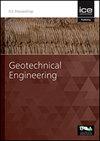Seismic responses of an underground tunnel in consideration of rock-tunnel interaction
IF 1.7
4区 工程技术
Q3 ENGINEERING, GEOLOGICAL
Proceedings of the Institution of Civil Engineers-Geotechnical Engineering
Pub Date : 2022-03-28
DOI:10.1680/jgeen.21.00076
引用次数: 0
Abstract
Existing earthquake damage reconnaissance reports indicate that many tunnels have suffered noticeable damage. During seismic excitation, ignoring the rock-concrete interaction may affect the accuracy of research results. In this study, the influence of rock-concrete interaction on the response behavior of a tunnel under seismic excitation was systemically investigated. A finite difference method (FDM) model of the tunnel and the full dynamic time history calculation technique were conducted. The rock-tunnel interface was built by the FDM and the interface element was defined by a linear Coulomb shear-strength criterion. The reliability of the numerical simulation of the interface was verified by comparing the numerical and direct shear test results. Based on a real engineering case, the Xianglushan water conveyance tunnel, two models with different rock-tunnel interaction treatments were established, and their seismic response were discussed. In addition, the mechanical properties of the interface were comparatively discussed. The tunnel seismic response behaviors were discussed in terms of displacements, stresses and lining dynamic internal forces. The results indicate that the presence of the rock-concrete interaction may have a significant effect on the seismic response of the tunnel, and the influence has a certain pattern. Furthermore, the influences of the mechanical parameters of the interface upon the seismic response of tunnels are complex, and the stiffness of the interface plays a significant role.考虑岩洞相互作用的地下隧道地震反应
现有的地震破坏侦察报告表明,许多隧道遭受了明显的破坏。在地震激励过程中,忽略岩石-混凝土相互作用可能会影响研究结果的准确性。本文系统地研究了岩石-混凝土相互作用对地震作用下隧道响应特性的影响。建立了隧道的有限差分模型和全动力时程计算技术。采用FDM方法建立岩洞界面,采用线性库仑剪切强度准则定义界面单元。通过数值与直剪试验结果的对比,验证了数值模拟界面的可靠性。结合相庐山输水隧道的实际工程实例,建立了两种不同岩洞相互作用处理的模型,并对其地震响应进行了讨论。此外,还对界面力学性能进行了比较讨论。从位移、应力和衬砌动力内力三个方面讨论了隧道的地震反应特性。结果表明,岩石-混凝土相互作用的存在对隧道的地震反应有显著影响,且这种影响具有一定的规律性。此外,界面力学参数对隧道地震反应的影响是复杂的,其中界面刚度起着重要的作用。
本文章由计算机程序翻译,如有差异,请以英文原文为准。
求助全文
约1分钟内获得全文
求助全文
来源期刊
CiteScore
4.40
自引率
4.50%
发文量
68
审稿时长
3 months
期刊介绍:
Geotechnical Engineering provides a forum for the publication of high quality, topical and relevant technical papers covering all aspects of geotechnical research, design, construction and performance. The journal aims to be of interest to those civil, structural or geotechnical engineering practitioners wishing to develop a greater understanding of the influence of geotechnics on the built environment.

 求助内容:
求助内容: 应助结果提醒方式:
应助结果提醒方式:


